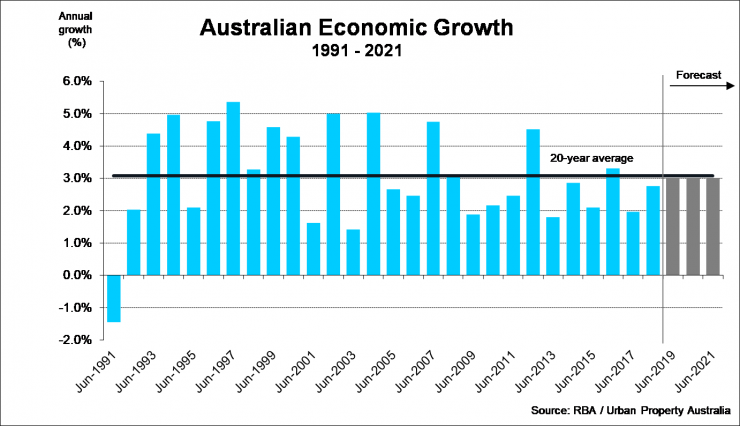Australian Economic Outlook – July 2018
July 25th 2018 | , Urban Property Australia
As Australia entered its 27th year of growth without a recession, the Australian economy grew at the fastest annual pace in two years in the first quarter of 2018. Over the year to April 2018, the Australian economy grew by 3.1%, up from 2.4% in the previous quarter. GDP growth in the first quarter of 2018 was supported by a rise in the value of exports coupled with elevated government infrastructure spending.
Boosted by widespread strength across both advanced and emerging economies globally, the Australian economy is forecast to grow by 3.75% in 2018/19 and 4.37% in 2019/20.
Household consumption is forecast to grow in 2018 and 2019, underpinned by income growth from solid employment conditions and strengthening wage growth, as well as increases in disposable income from the personal income tax measures.
Following the largest increase in employment ever recorded over the course of a calendar year in 2017, Australian employment continues to strengthen. As at May 2018, Australian total employment has reached an all-time high with 26,000 jobs created in 2018 to date. Employment growth has been broadly based across regions with the unemployment rate falling to 5.4%, its lowest level since October 2017.

Leading indicators such as job advertisements and business survey measures of hiring intentions are consistent with continued jobs growth. Australian employment growth is forecast to be 1.5% over the next two years to June 2020.
While the pace of dwelling investment has softened in recent quarters following solid growth over the past few years, the pipeline of work to be done and strength in approvals since mid-2017 are likely to keep dwelling investment elevated by historical standards through to 2020. Dwelling construction activity continues to be driven by a elevated levels in New South Wales and a continued flow of approvals in Victoria. However, there is a risk that weaker than expected housing price growth might curb investment intentions more than anticipated.
After four consecutive annual declines, there are now signs that a recovery in total business investment is underway, with a lift in momentum in non-mining business investment and should outweigh the remaining decline in mining investment. There is also evidence that increasing infrastructure investment in the public sector is having positive spillovers to investment in the private sector.
Government spending grew solidly in the first quarter of 2018 and is now more than 7% higher over the year. The Commonwealth’s 2018/19 Budget included a raft of new infrastructure proposals which should support the already elevated pipeline going forward. Indeed, the Victorian government’s recent Budget projects infrastructure investment, was more than double the 10-year average to 2014/15.
Accommodative monetary policy settings remain and are continuing to support key areas of the economy. The official cash rate remains at a historic low and has now been stable for the longest period in Australia’s history. This will continue to support both the household and business sectors. The Australian dollar also remains around 30% lower than its 2011 peak against the US dollar.
The Reserve Bank has left the official cash rate on hold for its 21st meeting in a row, at 1.5% as at July 2018. Given the environment of low wage growth, high energy prices, flat to falling house prices and consumer caution in the face of high debt levels, Urban Property Australia think that the RBA will hold the cash rate through 2018 with possible rises from mid-2019.
With the exception of Northern Territory, all Australian states and territories recoded growth in state final demand over the year to March 2018 with most above their respective 10-year averages. Victoria recorded the greatest growth, up 4.9% followed by Tasmania up 3.9% and New South Wales (3.7%). Western Australia continues to recover with annual demand growth of 0.8%, its third consecutive quarter of annual demand growth.



